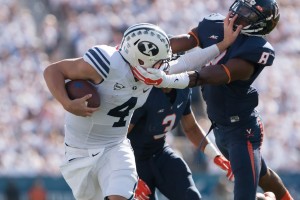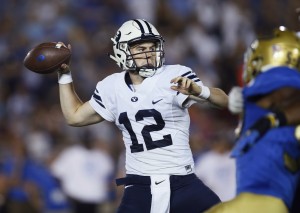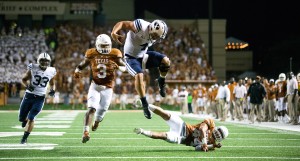
Last week Taysom Hill announced via Twitter he was returning to BYU for a fifth season.
The news sent Cougar fans into a frenzy as many had speculated Hill would transfer for his final year of eligibility. Michigan and Virginia were thought to be two schools he was heavily considering.
Head football coach Kalani Sitake was pleased to have Hill back.
“Taysom is a proven commodity and a great leader for our football team,” Sitake said. “We are thrilled to have him back for one more year.”
But now that Hill is returning to Provo, it puts the BYU football team in an interesting position.
After Hill went down with the third season-ending injury of his four-year career in the Cougars’ 2015 opener, a true freshman entered the game. A face so new that many couldn’t even pronounce his name correctly.
Two weeks and two Hail Mary victories later, everyone knew who Tanner Mangum was.
Depending on who you ask, the football team now has the problem or luxury of having both Mangum and Hill on the roster.
Offensive coordinator and quarterbacks coach Ty Detmer said it’s the latter.
“I’ve always said that two is better than one,” Detmer said at a press conference on Feb. 16. “Whoever’s in the game, we expect them to play at a high level and be able to compete. I know both guys can do that. They’ve proven that. For me, it’s great to have those two guys with experience.”
But, there’s an old football adage that goes “if you have two quarterbacks, you have none.”
This stems from the confidence required to be a signal caller. It’s a position that can’t be played defensively, wondering if and when you’ll be replaced by your backup. Traditionally, the divide between a starter and a second-string quarterback should be just large enough that the starter is safe, but close enough that the starter is pushed by the competition.
The most recent example of this took place at Ohio State.
Head coach Urban Meyer had three high-end starting quarterbacks on his roster entering the 2015 season. Meyer moved Braxton Miller, who finished fifth in the 2012 Heisman Trophy voting, to wide receiver.
He was left with Cardale Jones and J.T. Barrett. Barrett started 12 games for the Buckeyes in 2014, going 11-1, before breaking his right ankle. Barrett had thrown for 34 touchdowns, ran for 11 more and was the centerpiece of the Buckeyes’ offense.
In came Jones, who had only thrown two passes in his collegiate career. Jones led the Buckeyes to the 2014 National Championship.
Meyer decided to not name a starting quarterback heading into the 2015 season, revealing the starter to the team just minutes before opening their season.
By the third game of the season, Meyer was tinkering with his lineup mid-game, subbing Jones out for Barrett and vice-versa.
The Buckeyes finished 12-1 in 2015, but not thanks to their platooned quarterback play. Barrett and Jones combined for 19 touchdowns and nine interceptions. Both also saw significant drops in their quarterback rating.
Dual-quarterbacking may not be the answer for the Cougars. But Meyer also led the 2006 Florida Gators to a National Championship using two quarterbacks in a different way.
The Gators used Chris Leak and Tim Tebow that season. Leak was the traditional quarterback, while Tebow was used in certain packages and in the red zone.
Leak threw 365 passes in 2006, compared to Tebow’s 33. But Tebow ran the ball 89 times for nearly 500 yards.
The similarity between the Cougars’ current situation and the Gators’ 2006 season is striking.
Tanner Mangum is comparable to Chris Leak. Mangum is about three inches taller (6-foot-3) and 15 pounds heavier (225 pounds) than Leak, but their skill set is nearly the same. Both want to stand in the pocket and sling the ball downfield.
They’re even similar statistically. Mangum completed 267 of 446 passes last season for 3,377 yards, 23 touchdowns and 10 interceptions. Leak completed 232 of 365 passes in 2006 for 2,942 yards, 23 touchdowns and 13 interceptions.
Hill and Tebow share a fair number of similarities as well. Like Tebow, Hill’s most dangerous weapon is his athleticism. He has over 2,000 rushing yards and 24 rushing touchdowns in his career (Tebow had 2,947 rushing yards and 57 rushing touchdowns). As a passer, Hill’s not nearly as stellar. Throughout the majority of his career, Hill has struggled to throw a receiver open on a route and is guilty of getting “happy feet” in the pocket, opting to run when feeling pressure.
Hill and Tebow are similar in measurables as well. Hill stands 6-feet-2 and weighs 220 pounds. Tebow is 6-foot-2 and weighed 230 pounds as a Gator.
So perhaps there’s a viable way that Sitake and Co. can use both Mangum and Hill. Mangum can be the “starter,” who commands the offense 80 percent of the time and fills the traditional quarterback role. Hill can be the Tebow to Mangum’s Leak. Take 10-12 runs per game and throw a pass or two. He can be used in the red zone and in certain formations. It would keep the defense on its toes without creating a schism in the locker room over who should be starting.
It would also protect Hill. As he recovers from another major injury, he’ll miss the Cougars’ spring ball and will likely be behind in learning Detmer’s new offense. If they gave Hill a “limited” role, he may be able to stay healthy for the entirety of a grueling football schedule — something he’s only done once in his career.
But if it’s decided that a dual-quarterback system isn’t what’s best for the team, both Mangum and Hill have unique cases as to why they’re the best choice to start.
The case for Tanner Mangum

Mangum compiled one of the best freshman seasons in BYU football history last season. He was the first Cougar freshman to throw for 3,000 yards in a season and the first player to do so since Max Hall in 2009.
He was also named the Touchdown Club of Columbus Freshman of the Year. He joined the likes of Chris Leak, Adrian Peterson, Colt McCoy, Michael Crabtree, Julio Jones, Dion Lewis, Sammy Watkins and Todd Gurley (among others). Mangum also made Phil Steele’s All-Independent First Team.
But accolades are nothing new to Mangum.
Mangum was a blue-chip recruit coming out of Eagle High School in Idaho. He competed in the same Elite 11 quarterback camp as Heisman Trophy winner Jameis Winston. Mangum and Winston were both co-MVPs of the camp. The camp staff named Mangum their lone MVP.
Mangum also has youth and eligibility on his side. Mangum will be a sophomore next season, leaving him with three full seasons of eligibility remaining. Giving him more experience can only lead to more development. Last season BYU had five receivers with more than 450 receiving yards on the season. In Hill’s only full season (2013), BYU only had two receivers with those numbers.
Mangum has the chance to lead the offense for four straight seasons and seems to be a perfect fit for a new offense. Under the pro-style offense that Detmer wants to run, Mangum’s strengths would be heavily emphasized. Detmer has said he wants to put “a lot” on his quarterback’s shoulders. That includes audibles at the line of scrimmage and complex route packages. A typical pro-style offense usually limits quarterback runs and options plays as well, things that Mangum isn’t suited for.
The case for Taysom Hill

Hill was a potential Heisman candidate in 2014 after leading the Cougars to a 4-0 record. But a broken leg and Lisfranc injury later, it’s tough to imagine that he’ll be able to compete at a Heisman-level.
Still, the last we saw of Hill he was an elite athlete. Even though he can barely jog right now and will miss spring ball, one has to imagine that he will still be a top notch athlete.
Some might also feel that Hill is owed something. He’s given blood, sweat and tears to the program and has provided some of the best highlights in the history of program with his on-field play.
Hill’s dual-threat abilities and unique skill set can be a handful for opposing defenses. It’s tough to keep Hill contained in the pocket and even tougher to tackle him once he takes off. With a talented group of backfield mates, including the return of running back Jamaal Williams, having more option plays in the playbook couldn’t hurt. Hill was in the top-20 nationally in total rushing yards in 2013.
Overall
The coaching staff has emphasized multiple times that talent will win out.
“No one has been promised anything,” Detmer said to the Daily Herald in a press conference. “I know (Taysom) is a competitor. Tanner is a competitor. Everybody wants to play. Coach (Sitake) has said we’ll play the best 11 and we’ll go from there. They will all get their reps, then the best guy will play.”
The Cougars begin their season Sept. 3 against the Arizona Wildcats.




